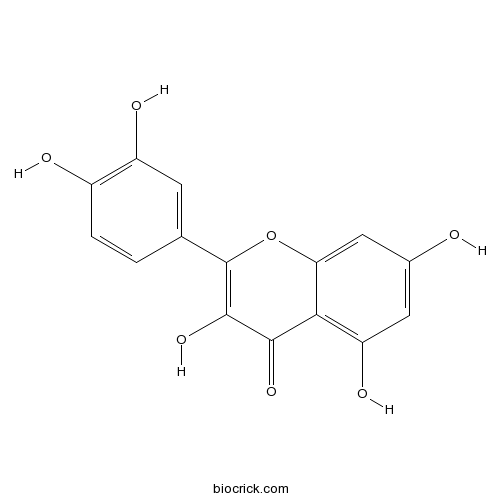Hypericum hookerianum
Hypericum hookerianum
1. The products in our compound library are selected from thousands of unique natural products; 2. It has the characteristics of diverse structure, diverse sources and wide coverage of activities; 3. Provide information on the activity of products from major journals, patents and research reports around the world, providing theoretical direction and research basis for further research and screening; 4. Free combination according to the type, source, target and disease of natural product; 5. The compound powder is placed in a covered tube and then discharged into a 10 x 10 cryostat; 6. Transport in ice pack or dry ice pack. Please store it at -20 °C as soon as possible after receiving the product, and use it as soon as possible after opening.
Natural products/compounds from Hypericum hookerianum
- Cat.No. Product Name CAS Number COA
-
BCN6049
Quercetin117-39-5
Instructions

Hypericin biosynthesis in Hypericum hookerianum Wight and Arn: investigation on biochemical pathways using metabolite inhibitors and suppression subtractive hybridization.[Pubmed: 25282172]
The biochemical pathway to hypericin biosynthesis is presumed to be polyketide synthase (PKS) mediated, but it has not been experimentally validated, and no alternate route (chorismate/o-succinylbenzoate pathway) has been analyzed. We report here our earlier developed auxin inducible culture systems of Hypericum hookerianum as a model, to study the metabolic pathway to hypericin synthesis. Inhibitors of the alternate pathway at varying concentrations showed steady synthesis of total hypericins with means of 2.80±0.22, 18.75±0.01; 16.39±3.75, 29.60±1.90 (mevinolin) 2.53±0.10, 18.12±0.56; 0.14±0.01, 14.28±1.11 (fosmidomycin) and 2.7±0.35, 18.75±0.61; 0.14±0.01, 12.80±1.09 mg g(-1) DW (glyphosate) in the control and auxin-induced shoot and shoot-forming callus cultures, respectively. SSH analysis classified the differentially expressed sequences into protein synthesis (38%), modification (20%), electron transport (9%) and remaining as unclassified (11%) and unknown proteins (22%). Functional annotation of sequences indicates the presence of additional protein components besides PKS activity. Our results demonstrate direct biochemical and molecular evidence of PKS hypothesis of hypericin biosynthesis for the first time.
Antioxidant activity of Hypericum hookerianum Wight and Arn.[Pubmed: 19731143]
Methanolic extracts of leaf, root, flower and aerial parts of Hypericum hookerianum were assessed for in vitro antioxidant activity using eight different models. Total antioxidant capacity, phenol and flavanol content of the extracts were determined to correlate between their antioxidant activity and constituents present therein. Results of in vitro antioxidant study suggest that extracts from leaf and flower have strong antioxidant potential. Leaf extract (100 & 200 mg kg(-1) b.w. p.o.) that showed maximum activity was selected for in vivo antioxidant studies using a CCl(4)-intoxicated rat model. The effects of extracts on lipid peroxidation (LPO), superoxide dismutase (SOD) and catalase (CAT) in serum and liver homogenate were analysed. CCl(4) treatment caused a significant increase in the level of CAT and SOD and a significant decrease in the level of LPO in a dose-dependent manner when compared to CCl(4) treated control. The results indicate the strong antioxidant nature of H. hookerianum leaf extract.
Antitumor activity of Hypericum hookerianum against DLA induced tumor in mice and its possible mechanism of action.[Pubmed: 17674426]
A large number of plants belonging to the genus Hypericum and their phytoconstituents are known to possess potent anticancer nature. Earlier studies from our laboratories indicated a strong cytotoxic nature of the methanol extract of Hypericum hookerianum stem (MEHH). In the present study, the in vivo antitumor activity of MEHH against the Dalton's lymphoma ascitic (DLA) model was determined at 100 and 200 mg/kg body weight given orally for 10 days. The results indicate that administration of the extract not only increased the survival of animals with ascites tumor, decreased the body weight induced by the tumor burden and reduced the packed cell volume and viable tissue cell count, but also altered many hematological parameters changed during tumor progression indicating the potent antitumor nature of the extract. Hematological and biochemical analysis were carried out to prove the anticancer and antioxidant nature of the extract.
Cytotoxicities of xanthones and cinnamate esters from Hypericum hookerianum.[Pubmed: 16041656]
5-Hydroxy-2-methoxyxanthone (1), 2-hydroxy-3-methoxyxanthone (2), trans-kielcorin (3), 4-hydroxy-3-methoxyphenyl ferulate (4) and 3beta-O-caffeoylbetulinic acid (5) were isolated from Hypericum hookerianum. Compounds 1-5 were tested against the growth of three human tumor cell lines, MCF-7, NCI-H460 and SF-268. Compounds 4 and 5 exhibited significant inhibitory activity effects against all three; GI50 values for 4 were 15.1 +/- 1.6, 18.7 +/- 2.3 and 15.9 +/- 2.7 and for 5 12.2 +/- 2.4, 19.6 +/- 2.3 and 24.3 +/- 2.5. Compound 3 was less active with GI50 values of 55.1 +/- 2.3, 49.7 +/- 3.0 and 40.5 +/- 1.5, while 1 and 2 exhibited only weak effects. Compounds 4 and 5 were moderately effective in influencing the mitogenic response to human lymphocytes to hemoagglutinin, with IC values of 26.1 +/- 3.6 and 40.8 +/- 4.9, respectively.
Antibacterial spectrum of Hypericum hookerianum.[Pubmed: 11429255]
The antibacterial activity of the chloroform, acetone and methanol extracts of Hypericum hookerianum leaves and stems was evaluated. All extracts showed antibacterial activity against six different gram-positive and gram-negative bacteria, the methanol extracts exhibiting the maximum inhibitory activity at 400 microg/ml.
The evaluation of wound-healing potential of Hypericum hookerianum leaf and stem extracts.[Pubmed: 10706238]
Hypericum hookerianum Wight and Arnott of the family Hypericaceae is a well-known plant among the 20 different species of Hypericum found in India. Because of its use as a wound-healing agent in traditional practices and literature references, the present study was undertaken to evaluate the wound-healing potential of this plant.


